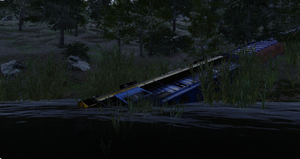Central Gateway Turtle Railroad: Difference between revisions
No edit summary |
|||
| Line 115: | Line 115: | ||
===Bluewashed=== | ===Bluewashed=== | ||
===Bluelined=== | ===Bluelined=== | ||
[[File:Trainiax CGTR Bluelined FP45.png|thumb|A Trainiax FP45 in CGTR Bluelined scheme.]] | [[File:Trainiax CGTR Bluelined FP45.png|thumb|A Trainiax {{wp|EMD FP45|EMD FP45 in CGTR Bluelined scheme.]] | ||
The Bluelined scheme was a CGTR scheme first seen in the early 1970s, appearing on passenger locomotives such as the | |||
===Hydrogold=== | ===Hydrogold=== | ||
===Bluewashed=== | ===Bluewashed=== | ||
Revision as of 21:44, 22 December 2023
 | |
 CGTR #3723, a Hydrogold livery GE U25C in 1973 (enhanced). | |
| Reporting mark | CGTR, GTLW, CGTZ, GTLX, TRTM |
|---|---|
| Dates of operation | 1874–Present |
| Predecessor | GAEA, TRLN |
| Track gauge | 4 ft 8 1⁄2 in (1,435 mm) standard gauge |
| Electrification | Third Rail |
| Headquarters | Fort Worth, TX |
| Website | cgtr |
The Central Gateway Turtle Railroad (Reporting mark CGTR, GTLW, CGTZ, GTLX, TRTM) is a Class I railroad located primarily in the Southern, Eastern, and Central regions of the United States, and headquarted in Fort Worth, Texas. The Central Gateway Turtle Railroad was founded in 1874 by the merger of Gateway Eastern and Turtle Northern, and has been operating since. In 1951, CGTR completely switched to diesel locomotives, ditching steam locomotives in favor of increasing profits. In recent years, CGTR has focused on cargo and shifted most passenger operations to TurtleTram, an experimental passenger/freight railway created by CGTR in 1989.
History
After the merger of Gateway Eastern and Turtle Northern in 1874, CGTR quickly placed the locomotives from both railways into service. These locomotives would be used until they were either replaced or retired. In 1940, CGTR would purchase their first diesel electric switching locomotive, an ALCO HH1000. CGTR would continue buying diesel-electric switchers after the HH1000, including EMD NW2s, Baldwin VO-660s, and many others. In 1948, CGTR would purchase 20 E7s and 6 Baldwin DR-12-8-1500/2s, marking the first non-switching diesel-electric locomotives purchased by CGTR. These would be unscheduled or leased out until mid-1951, when CGTR would ditch steam locomotives in favor of switching to diesel to increase profits. Some of the earliest diesel locomotives placed into operation on the CGTR would be the E7s, the DR-12-8-1500/2s, an FM Erie-Built and 2 B-Units purchased in 1949, and 9 EMD BL2s. These would be shortly followed by an expiremental diesel-hydraulic switcher built by EMD (the DH1), 3 ILW 17-As, and 57 EMD GP7s.
Incidents
Gulfport Runaway Incident
Equipment
Locomotives
As of late 2023, CGTR rosters 3,510 locomotives.
| Type | Quantity | Road Numbers | Notes |
|---|---|---|---|
| EMD F125 | 74 | 1-3, 14-25, 42-50, 300-349 | |
| GE P32AC-DM | 35 | 4-13, 6900-6924 | |
| EMD GP40FH-2 | 26 | 26-41, 6300-6309 | |
| EMD F59PHI | 8 | 51-58 | |
| GE ET44AC | 150 | 100-149, 9900-9999 | |
| EMD SD70ACe-T4 | 50 | 200-249 | |
| Wabtec FLXDrive | 90 | 400-459, 500-529 | |
| GTLW GP20-GT | 6 | 600-605 | Ex. GRR GP20 |
| GTLW SD40-GTHH | 55 | 5000-5054 | Rebuilt from SD40-2s |
| GTLW SD40-GTS | 39 | 5064-5102 | Rebuilt from SD40-2s |
| GTLW SD40-GT | 64 | 5116-5179 | Rebuilt from SD40-2s |
| EMD SW1504 | 24 | 5400-5423 | |
| EMD MP15AC | 50 | 5500-5549 | |
| GE B23-7 | 36 | 5700-5735 | |
| EMD GP39-2 | 17 | 5800-5816 | |
| GE C30-7 | 22 | 5900-5921 | |
| GE B30-7 | 78 | 6000-6077 | |
| GE B39-8 | 20 | 6100-6119 | |
| EMD MP15T | 20 | 6200-6219 | |
| GE C40-8 | 40 | 6400-6439 | |
| EMD F59PH | 33 | 6500-6532 | |
| EMD SD60M | 50 | 6600-6649 | |
| GE C40-8W | 70 | 6700-6769 | |
| GE C44-9W | 50 | 6800-6849 | |
| GE AC4400CW | 645 | 7000-7644 | |
| GE P42DC | 30 | 7700-7729 | |
| GE AC6000CW | 50 | 7800-7849 | |
| EMD SD70MAC | 30 | 7900-7929 | |
| EMD GP20D | 35 | 8000-8034 | |
| EMD SD9043MAC | 48 | 8100-8147 | |
| EMD SD70ACe | 308 | 8200-8457 | |
| GE ES44DC | 300 | 8500-8799 | |
| GE ES44AC | 455 | 8800-9254 | |
| GE ES44C4 | 553 | 9300-9852 |
Liveries
Classic Freight
Classic Passenger
Bluewashed
Bluelined
The Bluelined scheme was a CGTR scheme first seen in the early 1970s, appearing on passenger locomotives such as the

